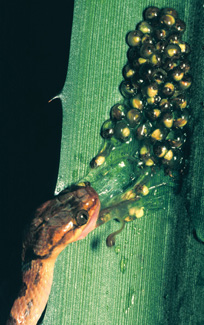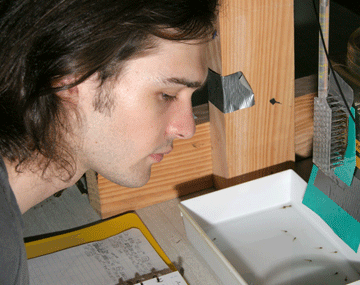151st ASA Meeting, Providence, RI
Bad Vibrations:
Treefrog Eggs Use Vibrational Cues to Flee from Predators
Karen M. Warkentin - kwarken@bu.edu
Michael S. Caldwell
J. Gregory McDaniel
Boston University
Boston, MA 02215
Popular version of paper 1pAB10
Presented Monday Afternoon, June 5, 2006
151st ASA Meeting, Providence, RI
Eggs are usually easy prey, and many are eaten. However, in some species near-term
embryos can hatch prematurely to flee from egg predators. The red-eyed treefrog,
Agalychnis callidryas, is the best studied case of such 'escape hatching.' This
frog lays its eggs on plants overhanging tropical rainforest ponds, where the embryos
are vulnerable to egg-eating snakes and wasps.

Red-eyed treefrogs laying eggs
When the tadpoles hatch, they fall into the water where they face a different set of predators.
Most undisturbed eggs hatch when they are relatively well-developed and their chance of
escaping enemies in the pond is high. If eggs are attacked, however, the embryos can hatch
up to 30% prematurely to escape.

Red-eyed treefrog eggs hatching
to escape from a cat-eyed snake
The response of red-eyed treefrog embryos to predators clearly depends on physical
disturbance, or movement, of the egg mass, but eggs can be moved by many benign forces,
such as wind and rain, as well as by predators from which they should flee. How do the
embryos know when to hatch, and when to ignore a disturbance? To understand what vibrational
information might be available to embryos, we assessed the mechanical properties of vibrating
egg clutches, and we recorded the vibrations of egg clutches during predator attacks and
rainstorms.
Leptodeira attack movie -- Infrared video recording of a cat-eyed snake attack on a red-eyed treefrog egg clutch, showing induced hatching. The sound track is the vibrations recorded from the clutch. Some of the vibrations are below the range of human hearing, but some are audible.
To test if vibrations cue premature hatching, and how particular vibration characteristics
affect hatching behavior, we exposed near-term eggs to controlled vibrations from a
mechanical shaker.

Graduate student Michael Caldwell running a vibration
playback experiment
We found that egg vibrations in snake attacks, wasp attacks, rain and wind overlap in individual frequency and temporal characteristics, but can be distinguished using combinations of features. Thus vibrations provide a plausible cue to danger. In our playback experiments, we found that escape hatching was induced by snake vibrations alone, without actual snakes, but that embryos did not hatch in equally intense vibrations recorded from rainstorms. Both frequency and temporal characteristics of vibrations affect the hatching response. Embryos use at least two features of the temporal pattern, the duration and spacing of vibrational disturbances, in their hatching decision. They hatch in response to only a limited range of low frequencies, but the concurrent presentation of higher frequencies (prevalent in rainstorms but not predator attacks) reduces hatching, refining the hatching response. Thus 'escape hatching' is not just a simple reaction to any and all physical disturbances of eggs. It is a complex process in which embryos sample vibrational information and use multiple features to assess risk and decide to hatch, or not. This is in keeping with both the irreversible nature of the hatching decision and the high risk to premature hatchlings from aquatic predators, in combination with the high risk from egg predators.
This research is the most detailed examination of mechanisms underlying embryo decision making to date. It suggests that the sensory world of embryos and their responsiveness to their environment may be more sophisticated than previously thought. It is also a clear demonstration of the importance of vibrational information in predator-prey interactions.

Red-eyed treefrog embryos ready to hatch at a moment's notice, but continuing to develop
in the egg
Readers can find additional images, movies, and information about this and other research projects at our lab web page.
[ Lay Language Paper Index | Press Room ]
|